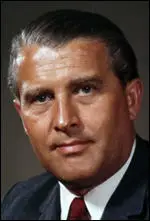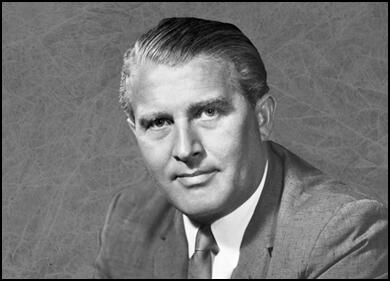Wernher von Braun

Wernher von Braun, the son of a Prussian baron, was born in Wirsitz, Germany in 1912. He studied engineering at Berlin's Charlottenburg Institute of Technology and after reading The Rocket into Interplanetary Space by Hermann Oberth, he became interested in rocket technology and helped form the German Society for Space Travel.
In 1932 Braun's achievements attracted the attentions of Walter Dornberger, who was in charge of the solid-fuel rocket research and development in the Ordnance Department of the German Army. Dornberger recruited Braun and in 1934 he successfully built two rockets that rose vertically for more the than 2.4 kilometres (1.5 miles).
Dornberger was appointed military commander of rocket research station at Peenemunde in 1937. Braun became technical director of the establishment and he began to develop the long-range ballistic missile, the A4 and the supersonic anti-aircraft missile Wasserfall.
During the Second World War Braun began working on a new secret weapon, the V2 Rocket. This 45 feet long, liquid-fuelled rocket carried a one ton warhead, and was capable of supersonic speed and could fly at an altitude of over 50 miles. As a result it could not be effectively stopped once launched.
Heinrich Himmler saw the military potential of Braun's research and took over control of the research station. Himmler became increasingly concerned about the motivation of Braun, considering him more interested in space travel than developing bombs. In March, 1944, Braun was arrested by the Gestapo and was only released when they became convinced that Braun was willing to use all his energies to develop this bomb that Himmler believed had the potential to win the war.
The V2 Rocket was first used in September, 1944. Over 5,000 V-2s were fired on Britain. However, only 1,100 reached their target. These rockets killed 2,724 people and badly injured 6,000. After the D-Day landings, Allied troops were on mainland Europe and they were able to capture the launch sites and by March, 1945, the attacks came to an end.
With the Red Army advancing on the Peenemunde Research Station, Braun and his staff fled west and surrendered to the US Army. Braun and 40 other rocker scientists were taken to the United States where they worked on the development of nuclear missiles.

In 1952 Braun became technical director of the US Army's Ballistic Missile Agency at Huntsville, Alabama and was chiefly responsible for the manufacture and successful launching of Redstone, Jupiter-C, Juno and Pershing missiles.
After the Soviet Union successfully launched Sputnik on 4th October, 1957, Braun concentrated on the development of space rockets and in January, 1958 launched Explorer I.
In 1960 Braun became director of the Marshall Space Flight Center where he developed the Saturn rocket that helped the United States to land on the moon in 1969.
When President Richard Nixon dramatically reduced the space budget in 1972 Braun resigned and became vice-president of Fairchild Industries, an aerospace company
Wernher von Braun, who wrote the books Conquest of the Moon (1953) and Space Frontier (1967) died of cancer at Alexandria on 16th June, 1977.
Primary Sources
(1) In an interview he gave to a journalist in October 1950, Wernher von Braun spoke about the political and moral consequences of going to work for the German Army on rocket technology in 1932.
In 1932, the idea of war seemed to us an absurdity. The Nazis weren't even in power. We felt no moral scruples about the possible future abuse of our brain child. We were interested solely in exploring outer space. It was simply a question with us of how the golden cow would be milked most successfully.
(2) Albert Speer, Germany's Minister of Armaments in the Second World War, was a strong supporter of the rocket programme headed by Wernher von Braun.
Ever since the winter of 1939, I had been closely associated with the Peenemunde development centre, although at first all I was doing was meeting its construction needs. I liked mingling with the circle of non-political young scientists and inventors headed by Werner von Braun - twenty-seven years old, purposeful, a man realistically at home in the future. It was extraordinary that so young and untried a team should be allowed to pursue a project costing hundreds of millions of marks and whose realization seemed far away.
My sympathy stood them in good stead when in the late fall of 1939 Hitler crossed the rocket project off his list of urgent undertakings and thus automatically cut off its labour and materials. By tacit agreement with the Army Ordnance Office, I continued to build the Peenemunde installations without its approval - a liberty that probably no one but myself could have taken.
(3) In a letter to R.W. Reid, the author of a book on science and morality, Wernher von Braun, wrote about the problems of developing new weapons for Adolf Hitler and his Nazi government (May, 1968)
With the tight press censorship imposed by Hitler, the abuses of his regime were not nearly as visible to the average German as they were to an outsider who had free access to the international news media. For this reason, I must say, more by way of a statement than as an apology, that I never realized the depth of the abyss of Hitler's régime until very late and particularly after the war, when all these terrible abuses were first published. I guess until about a year before the war's end I shared the feelings of most Germans that while Hitler was unquestionably an aggressor and a conqueror, that this put him more in a class with Napoleon than with the devil incarnate. While right from the beginning I deeply deplored the war and the misery and suffering it spread all over the world, I found myself caught in a maelstrom in which I simply felt that, like it or not, it was my duty to work for my country at war.
(4) Albert Speer wrote about the testing of Wernher von Braun's rocket in his autobiography, Inside the Third Reich.
On June 13, 1942, the armaments chiefs of the three branches of the armed forces, Field Marshal Milch, Admiral Witzell and General Fromm, flew to Peenemunde with me to witness the first firing of a remote-controlled rocket.
Wisps of vapour showed that the fuel tanks were being filled. At the predetermined second, at first with a faltering motion but then with the roar of an unleashed giant, the rocket rose slowly from its pad, seemed to stand upon its jet of flame for the fraction of a second, then vanished with a howl into the low clouds. Wernher von Braun was beaming. For my part, I was thunderstruck at this technical miracle, at its precision and at the way it seemed to abolish the laws of gravity, so that thirteen tons could be hurtled into the air without any mechanical guidance.
Approximately twenty-five feet long, the Wasserfall rocket was capable of carrying approximately six hundred and sixty pounds of explosives along a directional beam up to an altitude of fifty thousand feet.
(5) Albert Speer told Adolf Hitler about the A-4 rocket, on 14h October, 1942. Hitler was excited by the news as he was convinced that he now had a weapon that would win the war.
The A-4 is a measure that can decide the war. And what encouragement to the home front when we attack the English with it. This is the decisive weapon of the war, and what is more it can be produced with relatively small resources. Speer, you must push the A-4 as hard as you can! Whatever labour and materials they need must be supplied instantly. You know I was going to sign the decree for the tank program. But my conclusion now is: Change it around and phase it so that A-4 is put on a par with tank production. But in this project we can use only Germans. God help us if the enemy finds out about this business.
(6) R. V. Jones first became aware of the German VI Flying Bomb project in August, 1943.
On 22nd August an object had crashed in a turnip field on the island of Bornholm in the Baltic, roughly half-way between Germany and Sweden. It was a small pilotless aircraft bearing the number V83, and it was promptly photographed by the Danish Naval Officer-in-Charge on Bornholm, Lieutenant Commander Hasager Christiansen. He also made a sketch, and noted that the warhead was a dummy made of concrete.
At first, we were not sure what he had found. From his sketch it was about 4 metres long, and it might have been a rather larger version of the HS 293 glider bomb that KG100 was now using against our warships in the Mediterranean. Indeed, it turned out that this particular bomb had been released from a Heinkel III, but it was in fact a research model (the 'V' probably stood for 'Versuchs' i.e. research) of the flying bomb about which we were going to hear so much in the next few months.
Student Activities
Who Set Fire to the Reichstag? (Answer Commentary)
Adolf Hitler's Early Life (Answer Commentary)
Adolf Hitler and the First World War (Answer Commentary)
Adolf Hitler and the German Workers' Party (Answer Commentary)
Sturmabteilung (SA) (Answer Commentary)
Adolf Hitler and the Beer Hall Putsch (Answer Commentary)
Adolf Hitler the Orator (Answer Commentary)
An Assessment of the Nazi-Soviet Pact (Answer Commentary)
British Newspapers and Adolf Hitler (Answer Commentary)
Lord Rothermere, Daily Mail and Adolf Hitler (Answer Commentary)
Adolf Hitler v John Heartfield (Answer Commentary)
The Hitler Youth (Answer Commentary)
German League of Girls (Answer Commentary)
Night of the Long Knives (Answer Commentary)
The Political Development of Sophie Scholl (Answer Commentary)
The White Rose Anti-Nazi Group (Answer Commentary)
Kristallnacht (Answer Commentary)
Heinrich Himmler and the SS (Answer Commentary)
Trade Unions in Nazi Germany (Answer Commentary)
Hitler's Volkswagen (The People's Car) (Answer Commentary)
Women in Nazi Germany (Answer Commentary)

